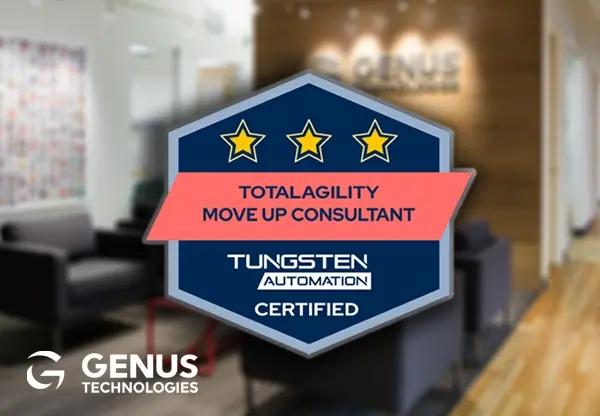Dynamic Ingestion Requirements Mandate Dynamic Forms
Document automation applications often have straightforward requirements. An ingested item belongs to a specific class, and that class includes...
3 min read

Recently Genus partnered with Tungsten Automation and Carahsoft to present a webinar outlining efficient constituent services within the public sector. The webinar outlined best practices and streamlined processes for delivering efficient constituent services. In this article, we go over a few takeaways to help you in your journey to offer efficient constituent services.
Challenges in Daily Operations
To better understand how to be more efficient in delivering constituent services, we need to look at some major challenges organizations face daily.
Collecting the right information – Documents comprise a large part of our daily workflow. Challenges arise when those documents need to be sent and received. For example, pay stubs, tax returns, licenses, and other verifiable documents, including documents that need to be signed.
Communicating over a broad area – Communicating with constituents about available services, physically delivering those services, and requiring in-person visits to government offices can be a big challenge.
If you don’t design experiences that can happen remotely or with digital documents, you risk negatively affecting constituents and exhausting resources.
Hybrid workforce – Combining in-office work with remote work is challenging for many organizations. At the same time, it’s an accelerated trend that requires change. Not only do employees and case workers need to have access to their daily applications easily, but they also need that access to be secure.
Collaboration and workflow – Employees and case workers need to collaborate with people effectively and be provided with effective collaborative tools, maintenance, and support.
Relying on a super-knowledge worker – The risks are obvious when organizations or departments depend on one or two workers for specific duties.
Paper-based workflow – Using and relying on paper is a huge challenge for many organizations. It’s slow, error-prone, and traps data in a stifling container. Plus, storage is expensive and can be a security risk. This offers a huge opportunity to implement digital processes.
Benefits of Implementing Digital Processes
Challenges bring opportunities. So, let’s look at the many opportunities agencies or departments can benefit from by upgrading digital capabilities.
Save time and reduce costs – Digital transformation reduces long-term costs and lowers the risk of human error. And for workers, building applications using the right low-code development tools and generating automated processes eliminate tedious tasks such as data entry and repetitive and mechanical tasks.
Access information securely and remotely – Allowing teams to access projects remotely in a secure environment, especially while segmenting permissions between departments, can be difficult. Unless you’re working with a platform that handles nuanced security constraints natively.
Deploying security solutions while abiding by strict access controls put in place by security teams provides workers with confidence that they can then pass on to the people they serve.
Enhancing visibility and transparency – Achieving efficient and effective constituent services requires clear visibility and a concise roadmap from beginning to end, but it does take time. Recognizing where agencies or departments can do better is a good start.
Also, try to identify which users need training, which can be used as positive examples for others, and which steps in the process can be done in parallel. By realizing this type of visibility, users will be more in control of their daily work and improve overall quality throughout their organization.
Quickly respond to audits and requests – Applying digital processes will help produce operational data (including associated documents) in a matter of minutes instead of days.
Tapping into heightened operational visibility proactively enhances operations for your teams and constituents’ benefit.
Mapping Out Your Digital Transformation Journey
The first step to delivering more effective constituent services is to start by leveraging the technology already at our fingertips. Here are a few places to start.
Change the way we deal with change – From a technology adoption perspective, the best way to deal with change is to prepare ourselves mentally. Adopt a methodology that embraces change, such as Agile.
Embrace tools that make change easy. For example, don’t settle for tools that are hard-coded because requirements will change, and you don’t want to be stuck with a static tool.
Let people be people – By nature, people are social, creative, joyful, and connected. Find opportunities to take away cold mechanical tasks so they can bring their special talents and abilities to their work. The center of IA is to take away mundane tasks so workers can participate in higher-level work and training.
Implement and iterate – We don’t know how a change will affect an operation, how users will adopt a new system, or if the direction will be the right one. But we do know that we need to put hypotheses into play, learn from the experiences, and implement the process.
This takes trust from management and users that your team has their best interests at heart and that their feedback will be valued.
Ask the right questions – When it comes to looking at organizational processes, it’s important to ask good questions to your constituents, such as:
In Conclusion
Upgrading digital capabilities within organizations is the beginning of adding value to your overall processes. By implementing some of the steps outlined here and adding effective tools and platforms, you’ll improve constituent service delivery and build trust.
At Genus, we aim to add value to our customers and help improve their constituent services by providing intelligent document automation, process transformation, and digital modernization, including cloud services.
If you’re interested in learning more or need help creating a constituent service roadmap, contact sales@genustechnologies.com.
We invite you to watch the webinar in its entirety – “How to Create Efficient Constituent Services”
For more tech tips, remember to subscribe to Genus Blogs!

Document automation applications often have straightforward requirements. An ingested item belongs to a specific class, and that class includes...

Batch Class Import Have you ever configured a batch class to import electronic documents (i.e., eDocuments in Tungsten Automation, and noticed that...

Genus Technologies is proud to announce that we are the first to be recognized as a Certified Move-Up Consultant by Tungsten Automation. This...